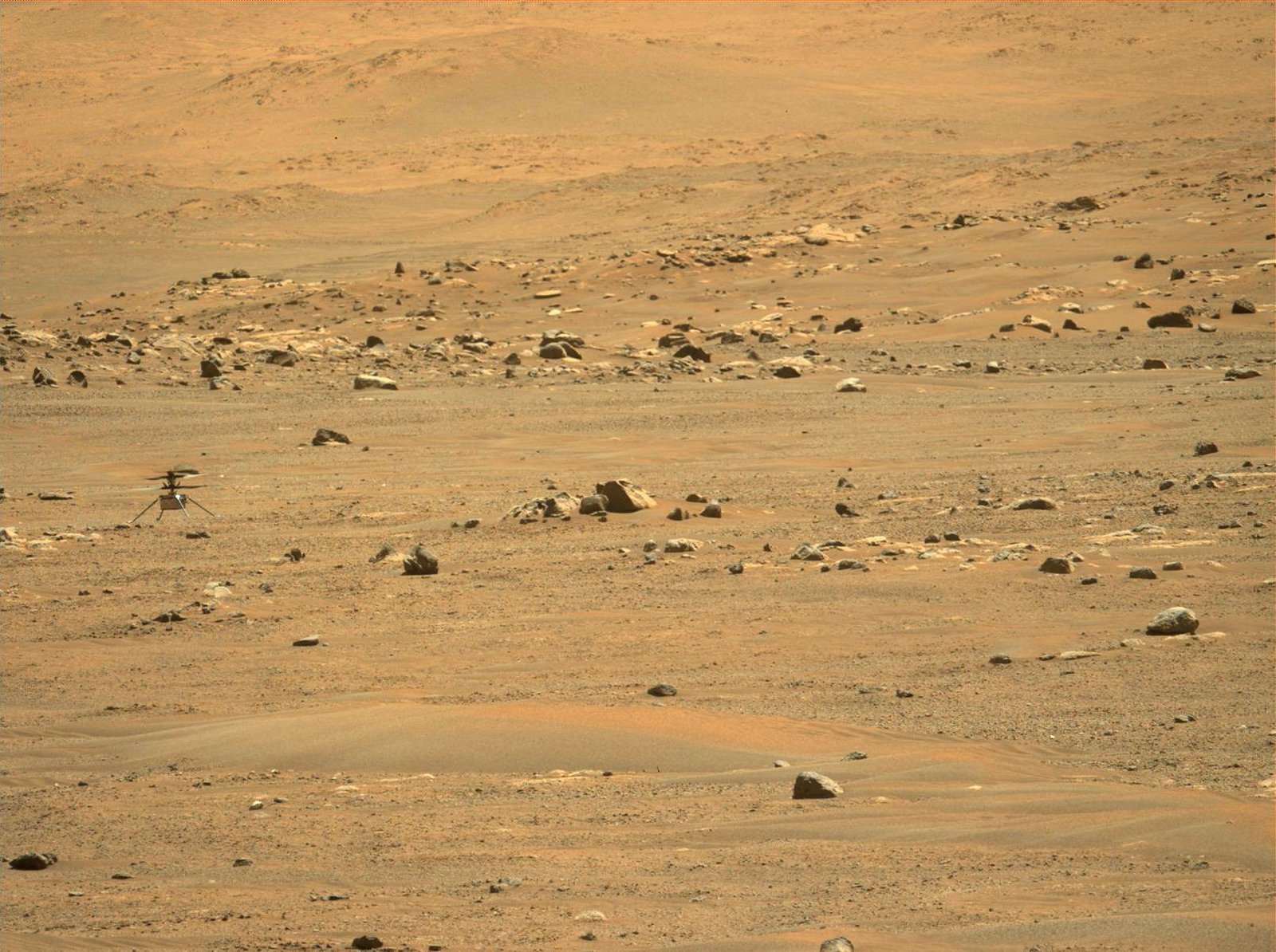NASA's Ingenuity Mars helicopter is now exploring a new airfield on the Red Planet.
Ingenuity made its fifth Martian flight today (May 7), lifting off from the floor of Jezero Crater at 3:26 p.m. EDT (1926 GMT). The 4-lb. (1.8 kilograms) chopper climbed to an altitude of 16.5 feet (5 meters) and cruised south for 423 feet (129 m), following the same path it took last week on flight number four, NASA officials said.
But unlike that April 30 jaunt and the three others that preceded it, today's trip was one-way. After reaching its destination, Ingenuity climbed to 33 feet (10 m) — twice as high in the Martian sky as it had ever gotten — snapped some photos and then landed in a new place, wrapping up a 108-second flight and embarking on a new journey of exploration.
Video: See the view on Mars from Ingenuity helicopter's fourth flight

"We bid adieu to our first Martian home, Wright Brothers Field, with grateful thanks for the support it provided to the historic first flights of a planetary rotorcraft," Bob Balaram, Ingenuity chief engineer at NASA's Jet Propulsion Laboratory (JPL) in Southern California, said in a statement today.
"No matter where we go from here, we will always carry with us a reminder of how much those two bicycle builders from Dayton meant to us during our pursuit of the first flight on another world," Balaram said.
Excelsior! The #MarsHelicopter completed its 1st one-way trip and 5th flight on Mars. It touched down at its new location, kicking off a new demo phase where we test this new tech and see how it can aid future missions on Mars and other worlds. https://t.co/TNCdXWcKWE pic.twitter.com/YwxIjupbQIMay 8, 2021
Ingenuity landed with NASA's Perseverance rover inside the 28-mile-wide (45 kilometers) Jezero on Feb. 18. The solar-powered rotorcraft deployed from the rover's belly on April 3, beginning a flight campaign designed to demonstrate that aerial exploration is possible on Mars.
Breaking space news, the latest updates on rocket launches, skywatching events and more!
That campaign was supposed to end after 30 days and a maximum of five flights. But Ingenuity performed so well, and remains so healthy, that NASA recently extended its mission.
"Our helicopter is even more robust than we had hoped," Josh Ravich, Ingenuity mechanical engineering lead at JPL, wrote in a blog post yesterday (May 6).
"The power system that we fretted over for years is providing more than enough energy to keep our heaters going at night and to fly during the day," Ravich added. "The off-the-shelf components for our guidance and navigation systems are also doing great, as is our rotor system. You name it, and it’s doing just fine or better."

Today's flight helps transition the little chopper into a new phase, during which Ingenuity will showcase the ability of rotorcraft to serve as scouts for Mars rovers. The new airfield lies along Perseverance's planned traverse, so the helicopter's in-flight photos could help the rover team choose the most efficient route and, perhaps, identify interesting rock targets to investigate.
Keeping the two robots in relatively close proximity is also a logistical necessity. Ingenuity, whose body is about the size of a tissue box, cannot talk directly to its handlers on Earth; communications to and from the chopper must go through Perseverance.
In addition to serving as a relay station, the rover has been documenting Ingenuity's historic flights, capturing video and, on flight number four, audio of the rotorcraft in action. But Perseverance will soon begin focusing in earnest on its own science mission, which involves hunting for signs of ancient Mars life and collecting and caching dozens of samples for future return to Earth.
"The plan forward is to fly Ingenuity in a manner that does not reduce the pace of Perseverance science operations," Balaram said in today's postflight statement.
"We may get a couple more flights in over the next few weeks, and then the agency will evaluate how we're doing," he added. "We have already been able to gather all the flight performance data that we originally came here to collect. Now, this new operations demo gives us an opportunity to further expand our knowledge of flying machines on other planets."
Mike Wall is the author of "Out There" (Grand Central Publishing, 2018; illustrated by Karl Tate), a book about the search for alien life. Follow him on Twitter @michaeldwall. Follow us on Twitter @Spacedotcom or Facebook.
Join our Space Forums to keep talking space on the latest missions, night sky and more! And if you have a news tip, correction or comment, let us know at: community@space.com.

Michael Wall is a Senior Space Writer with Space.com and joined the team in 2010. He primarily covers exoplanets, spaceflight and military space, but has been known to dabble in the space art beat. His book about the search for alien life, "Out There," was published on Nov. 13, 2018. Before becoming a science writer, Michael worked as a herpetologist and wildlife biologist. He has a Ph.D. in evolutionary biology from the University of Sydney, Australia, a bachelor's degree from the University of Arizona, and a graduate certificate in science writing from the University of California, Santa Cruz. To find out what his latest project is, you can follow Michael on Twitter.
